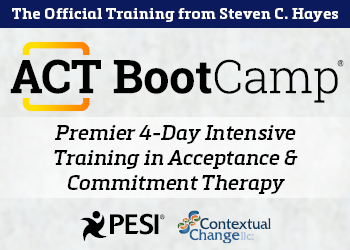Objectives
Introduction to ACT and the Extended Psychological Flexibility Model
- Describe the six processes that underlie psychological flexibility/inflexibility.
- Describe the importance of context in understanding client difficulties.
- Describe the concept of workability in ACT.
- Identify at least 2 in-session exercises that are designed to promote psychological flexibility.
- Demonstrate how acceptance, defusion and other forms of cognitive and emotional flexibility work together in supporting openness to experience.
- Demonstrate how flexible attention to the now and a perspective-taking sense of self assist in establishing awareness.
- Demonstrate how values and committed action support meaningful living.
ACT Model and Methods
- Describe how the use of perspective-taking and awareness are essential to creating flexibility.
- Demonstrate how committed action and values clarification work together in creating meaning and behavioral goals.
- Describe the essential characteristics of the therapeutic relationship from an ACT point of view, including intrapersonal and interpersonal processes.
- Appraise the ACT therapeutic stance.
- Analyze the ACT therapeutic relationship and its core competencies.
- Describe how flexibility processes are essential to and part of a socially extended process for relational change.
ACT Skills-Building Intensive
- Apply psychological flexibility processes to the therapeutic relationship.
- Describe the three overall and essential functions of the ACT clinician regarding psychological flexibility in the therapy session.
- Describe at least one way of reading each flexibility process as it shows up in session.
- Demonstrate the ability to detect flexibility-relevant material in session.
- Utilize at least one generally useful method of opening the door to each of the flexibility processes in session.
- Utilize ACT (skills, interventions, techniques) to shift the focus to any flexibility target at will.
- Respond to client statements using flexibility processes.
Therapist Wisdom and Bringing the Process of Change to Light
- Describe why the network approach is a radical shift in case conceptualization.
- Identify the psychological, biological and sociocultural nodes of a network.
- Develop an individualized ACT treatment plan.
- Utilize network modeling in case conceptualization.
- Integrate ACT with existing training, background, and experience as a practitioner.
- Create ACT-based interventions to cultivate compassionate wisdom in clients.
Objectives for Optional Evening Sessions:
Flexible Implementation of ACT
- Use core psychological flexibility processes to focus on interpersonal connection and being bold in therapy.
- Use core psychological flexibility processes to foster creative hopelessness.
- Apply the flexible use of multiple core processes in a single episode of contact with a client.
Clinical Examples and Case Conceptualization
- Utilize core psychological flexibility processes with challenging or stuck clients.
- Practice core psychological flexibility processes to focus on qualities of the interpersonal relationship.
- Formulate a case conceptualization using ACT interventions.
Note: The state of the evidence, risks and limitations, and contraindications will be addressed throughout the training as appropriate.










